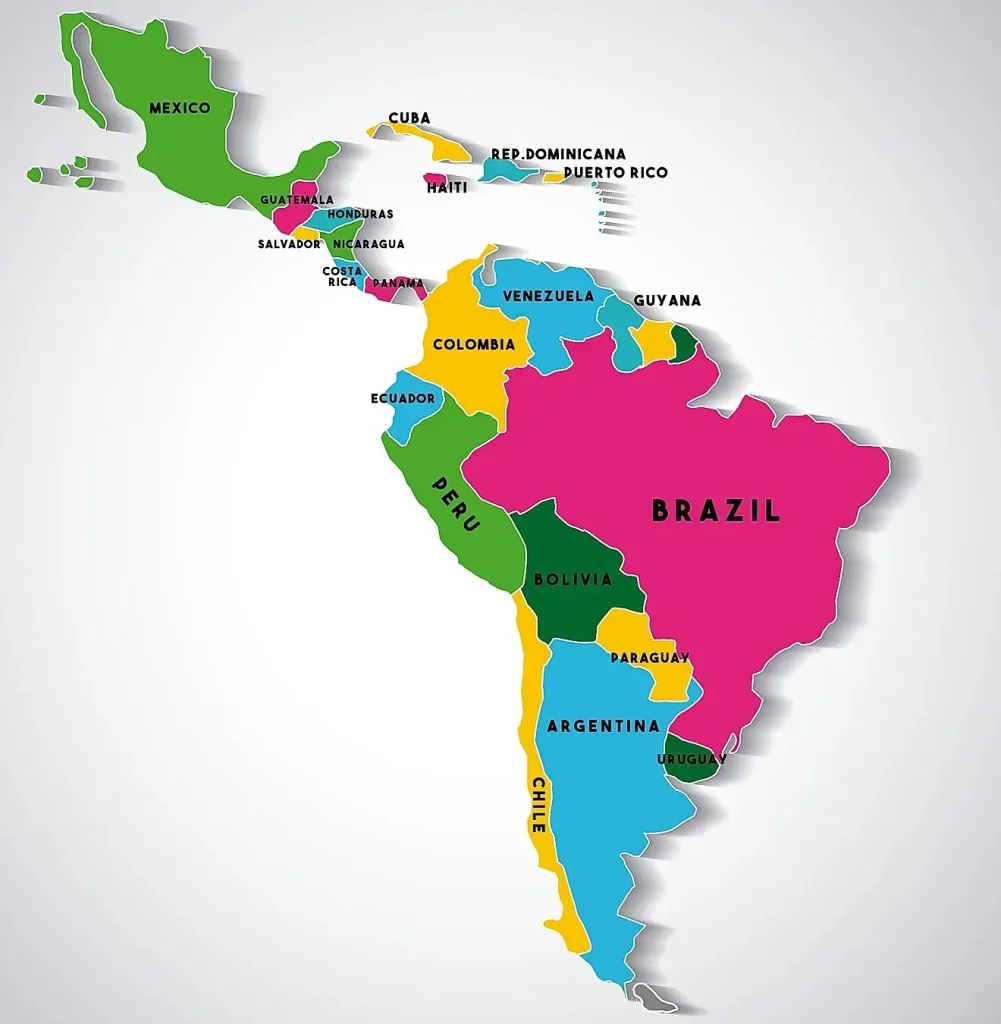Latin Americans and America share a complex and often tumultuous relationship that has shaped the identity and historical narrative of both regions. The recent executive order by President Trump to rename the Gulf of Mexico as the “Gulf of America” has reignited debates surrounding the interpretation of America, particularly among Latin Americans who view it as a collective term for their diverse nations. In his book, “America, América,” Pulitzer Prize-winning author Greg Grandin highlights the intertwined histories of Latin America and the United States, illustrating that Spanish influence was pivotal in America’s fight for independence. This longstanding connection challenges traditional perceptions and demonstrates that Latin American identity is an integral aspect of America’s broader history. By acknowledging such dynamics, we can better understand the nuances of the Monroe Doctrine interpretation and the historical weight it carries for both Latin Americans and Americans today.
The ties between Latin nations and the United States are steeped in a history that transcends borders and reflects a multifaceted cultural tapestry. This relationship, often viewed through the lens of power dynamics and historical intervention, has led to conflicting interpretations of what it means to be part of the Americas. As seen in discussions surrounding the Gulf of America and historical texts like Greg Grandin’s latest work, both sides grapple with the implications of sovereignty, identity, and mutual respect within this vast region. The legacies of influential figures, from Bolívar to contemporary Latino leaders, testify to the ongoing struggle for recognition and equality that characterize the Latin American experience in relation to their northern neighbors. By exploring these narratives, we can unlock a deeper understanding of how both Latin Americans and Americans navigate their shared destiny in this rich geographical and ideological landscape.
Understanding Latin American Identity in the Context of America
Latin American identity is rich and complex, deeply intertwined with the broader American landscape. For many in Latin America, the identity transcends national boundaries, defining themselves as part of a vast and shared cultural and historical fabric that extends from the southern tip of Argentina to the northern reaches of Canada. This perspective challenges the traditional U.S.-centric view of America, which often reduces it to the experiences and narratives of the United States alone. Instead, the acknowledgment of a shared Latin American identity serves to highlight the diverse histories, struggles, and triumphs that echo throughout the entire continent.
In his book, ‘America, América,’ Greg Grandin illustrates how the events of Latin America are essential to understanding the broader history of America. He emphasizes that contributions from Latin American figures, particularly during pivotal moments such as the American Revolution, showcase the deep connections that have historically existed across the hemisphere. The perspective of Latin Americans is not just of followers but of participants in a larger narrative, emphasizing their role in shaping the history and identity of America as a whole.
The Gulf of America: A Symbol of Shared Identity
The recent proposal to rename the Gulf of Mexico to the “Gulf of America” symbolizes a larger conversation about identity and ownership among Western nations, particularly the U.S. and Latin American countries. This change is ripe with implication, as it can be seen as an attempt by the United States to assert its dominance over a body of water that has significant historical and cultural meaning for Latin Americans. The Gulf of America, as a designation, can be interpreted as inclusive, reflecting the shared heritage of the Americas, yet it simultaneously raises questions about whose narrative is being prioritized and whose history is being overshadowed.
Latin Americans perceive the term “America” as a representation of all countries within the continent, thus the Gulf’s renaming creates an opportunity to rethink and redefine ownership and regional identity. Anthropologist Jorge Giovanetti’s observation that this name change might inadvertently reclaim the Gulf for all of the Americas resonates profoundly with notions of shared sovereignty. If the Gulf becomes a symbol not just for the U.S., but for Latin America as well, it emphasizes the importance of inclusivity in an often fragmented political and cultural discourse.
Interpreting the Monroe Doctrine in Modern Context
The Monroe Doctrine, articulated in the early 19th century, remains a pivotal concept in understanding the historical dynamics between the United States and its Latin American neighbors. Initially regarded as a protective measure for nascent Latin American nations against European intervention, its interpretation has evolved over time. Greg Grandin points out that while leaders like Simón Bolívar embraced the doctrine as a signal of support for their independence movements, it soon transformed into a justification for U.S. interventions, reflecting a more imperialistic agenda. This duality is crucial in dissecting how the doctrine has affected Latin American perceptions of U.S. intentions.
Today, the Monroe Doctrine can be seen as a lens through which we evaluate ongoing U.S. foreign policy towards Latin America. The inherent ambiguity of the doctrine, as Grandin notes, has allowed it to oscillate between being a protective policy and a vehicle for intervention. As contemporary discussions around sovereignty and self-determination unfold, it becomes evident that understanding the Monroe Doctrine’s legacy is paramount in navigating the complex relationships between the U.S. and its southern neighbors.
Historical Perspectives on American Expansionism
The expansionist ideologies that characterized the early years of American history are central to understanding how Latin America fits within this narrative. Greg Grandin’s analysis in ‘America, América’ highlights the contrasting views between U.S. leaders who saw expansion as a form of exceptionalism and those in Latin America who recognized the impending threat of dominance. Figures like Jefferson who envisioned a continent dominated by Anglo-Americans exemplified the imperial mindset, while Latin American leaders advocated for a united continent based on mutual respect and sovereignty.
This historical context provides invaluable insight into the present-day challenges faced by Latin American countries navigating their relationships with the U.S. The complicity of American foreign policy in the region’s political dynamics often paints the U.S. as a historical culprit—a position that stirs lingering resentment and complicates diplomatic relations. In recognizing and addressing this history, both sides can move towards a more equitable partnership.
Influence of Social Democracy in Latin America
The rise of social democracy in Latin America contrasts sharply with the political landscape of the United States, where discussions around social welfare policies often become polarizing. Grandin’s assertion that three-quarters of Latin Americans live in countries governed by social-democratic administrations suggests a deep-seated commitment to social justice—a narrative often overshadowed by the more individualistic ideologies prevalent in the U.S. This divergence highlights the distinct paths that the Americas have taken, with Latin Americans embracing collective governance to address systemic inequalities throughout their histories.
As many Latin American nations navigate the pressures of globalization and neo-liberal economic policies, their adherence to social democratic principles underscores a drive for greater equity and social rights. The ongoing struggle for healthcare, education, and economic justice manifests in various forms, leading to a rich mosaic of movements aimed at social reform. Understanding these dynamics opens pathways for collaboration across the Americas, where shared aspirations for democracy and equity can unite diverse populations.
Reflections on Latin American Literary Contributions
Literature has long served as a mirror reflecting the intricate realities of Latin American identity and history. As Grandin noted in ‘America, América,’ the narratives of authors throughout the region provide crucial insights into the ongoing struggle against imperialism and for self-definition. The literature emerging from Latin America often yields powerful critiques of colonialism, capitalism, and the complexities of cultural identity, establishing a dialogue with readers worldwide on these pressing issues.
Furthermore, the works of writers such as Gabriel García Márquez and Clarice Lispector illuminate the Latin American pursuit of identity, often intertwining the personal with the political. These literary voices have critical roles in shaping the understanding that Latin Americans are not merely subjects of U.S. history but active participants shaping their narratives in the face of adversity. They paint a picture that emphasizes resistance and resilience, reminding readers that the essence of what it means to be American extends far beyond mere geography.
Tracing the Legacy of Colonialism in Contemporary America
The lingering effects of colonialism continue to ripple throughout the Americas, influencing contemporary socio-political landscapes in both Latin American and U.S. contexts. Grandin’s examination of the historical narratives surrounding figures like Bartolomé de las Casas reveals the contentious struggles over humanity and rights that defined colonial frameworks. By tracing these legacies, we uncover how historical injustices contribute to modern-day inequalities, particularly in the ways different communities in both the U.S. and Latin America are treated.
Understanding these colonial legacies not only enriches our comprehension of current socio-political conflicts but also emphasizes the vital necessity for healing and reconciliation. As discussions continue around reparative justice and acknowledgment of historical wrongs, examining the connections between past and present can guide more equitable futures for all Americans. Addressing these legacies is essential for creating a unified identity that honors the complexity and richness of the shared American experience.
Future Directions for Inter-American Relations
As the geopolitical landscape continues to evolve, the future of inter-American relations demands a reevaluation of historical narratives and mutual recognition. Greg Grandin’s perspective reinforces the idea that the shared destinies of Latin Americans and Americans lie in embracing common challenges while celebrating their differences. Fostering respectful dialogue and collaboration on issues like trade, immigration, and climate change can fortify relationships across the hemisphere, promoting a vision of solidarity rather than division.
The concept of America as a united entity, encompassing myriad identities and experiences, holds transformative potential for both regions. Embracing this shared identity can pave the way for cooperative strategies that address pressing challenges faced by both Latin America and the United States. Achieving this involves dismantling myths of separation and exclusivity, allowing for a future where unity in diversity is not just aspirational but attainable.
Comparative Analysis of Leadership Styles in the Americas
Leadership styles across the Americas highlight distinct political cultures that reflect the regions’ histories and identities. Latin American presidents often emerge from revolutionary backgrounds, pushing for dramatic changes in societal structures, while U.S. leaders frequently lean towards incremental reforms that align with established systems of power. Examining these differences helps illuminate how distinct historical forces shape political decisions and public expectations within each region.
Moreover, understanding the nature of political leadership in both contexts also sheds light on citizen engagement and activism. In Latin America, grassroots movements frequently challenge leadership to fulfill democratic promises, contrasting with the sometimes complacent civic engagement observed in the U.S. The interplay between leadership and popular advocacy offers valuable lessons for enhancing democracy across the Americas, reinforcing the importance of accountability and participatory governance.
Frequently Asked Questions
How does Latin American identity differ in its understanding of America compared to the United States?
Latin Americans view America as a unified geographic and cultural entity that encompasses all the nations of the continent, from the southern tip of Chile to northern Canada. This perception contrasts sharply with the American view, where ‘America’ often refers only to the United States, creating a complex dynamic in identity and nationalism throughout the hemisphere.
What historical contributions have Latin Americans made to America’s history?
Latin Americans have significantly contributed to America’s history, notably during the U.S. fight for independence. Figures like Bernardo de Gálvez played crucial roles, showing that the revolutionary spirit transcended borders and illustrating the interconnectedness of Latin American and American histories.
How has the Monroe Doctrine shaped Latin American relations with the United States?
The Monroe Doctrine has been pivotal in shaping U.S. involvement in Latin America, asserting that the U.S. had the right to intervene in the region to protect its interests. Initially welcomed by some Latin American leaders for its anti-colonial stance, it later fostered skepticism as it often justified U.S. interventions that undermined their sovereignty.
What insights does Greg Grandin offer in his book about Latin Americans and their perception of America?
Greg Grandin’s book, “America, América,” explores the intertwined histories of Latin America and the United States, highlighting how Latin Americans have historically seen themselves as crucial to America’s narrative, while also addressing how U.S. actions often marginalized their contributions and sovereignty over time.
In what ways did Latin American leaders influence American democracy?
Leaders such as Simón Bolívar viewed the United States as a model for democracy and sought to replicate its ideals in Latin America. Bolívar and others believed that achieving a unified and democratic hemispheric identity was essential in opposing monarchy and promoting self-governance across the Americas.
How does the changing political landscape in Latin America challenge the perception of idea of America?
The political landscape in Latin America, with a rise in social-democratic governance alongside authoritarian regimes, reflects diverse interpretations of democracy and identity within the Americas. This evolving dynamic challenges simplistic narratives and highlights the complexity of Latin American political identity as part of the broader American story.
Why is it significant that Latin Americans view the Gulf of Mexico as the Gulf of America?
Renaming the Gulf of Mexico to the ‘Gulf of America’ symbolizes a broader understanding of American identity that includes all countries of the Americas. This reflects Latin America’s claim to a shared history and geographical identity, countering perceptions that limit ‘America’ to the U.S. alone.
What role do social democratic movements in Latin America play in the broader context of American history?
Social democratic movements in Latin America are significant as they represent a commitment to addressing social rights and inequality, emphasizing a shared destiny among Americans. This contrasts with historical U.S. policies, suggesting potential pathways for future collaboration and unity within the Americas.
How does the legacy of figures like Bartolomé de las Casas influence modern Latin American identity?
The legacy of Bartolomé de las Casas, who advocated for the rights of Indigenous peoples, shapes modern Latin American identity by highlighting historical struggles against oppression and the pursuit of human dignity. His ideas resonate with contemporary movements for social justice across the region.
What potential future does Greg Grandin envision for Latin American relations with America?
Greg Grandin envisions a future where Latin Americans and Americans unite through shared histories and cooperative efforts toward social democracy. He argues that recognizing mutual interests and challenges can pave the way for a more equitable and interconnected American continent.
| Key Points |
|---|
| President Trump’s executive order renaming the Gulf of Mexico raises conflicting interpretations of ‘America’ between the U.S. and Latin Americans. |
| Latin Americans view ‘America’ as encompassing all lands from the south to the north, contrasting with the U.S. perception of America as synonymous with the U.S. |
| Historical contributions of Spanish and Latin Americans to U.S. independence, including figures like Bernardo de Gálvez. |
| Simón Bolívar’s vision of a unified America versus the exclusionary views of U.S. Founding Fathers. |
| The Monroe Doctrine’s ambiguous implications for U.S.-Latin America relations and interventions. |
| Grandin’s ‘America, América’ explores Latin American historical perspectives and their struggles for social democracy. |
| Recent political shifts in Latin America could affect the future viability of social democracy. |
Summary
For Latin Americans and America, the discussion of what America signifies is a complex tapestry woven from history, cultural identity, and political discourse. The differing views on the concept of ‘America’ reflect deep-rooted historical relationships and contemporary perspectives that can either divide or unite the nations of the hemisphere. Understanding these key points highlights the urgency for a shared future that respects the contributions of all national identities within the Americas.



